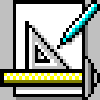


|
|

|
|||
|
|
|
A successful product represents the combination of a good basic design concept that is timely, ease of manufacturing and repairability, reliability, and doing a specified job. Most artifacts represent a compromise between these items. This exercise is set up to give students some hands-on exposure to all aspects of a successful design.
The "Bodiometer Design Contest" (patterned after a similar contest held in ME210 taught by Professor Larry Leifer at Stanford University) is an event in which students design, produce, and operate a device using largely unmodified parts from a Lego Technic Building Set. The product is a "bodiometer" which performs 4 critical body measurements: wingspan, handweb, temporal skull circumference, and chest circumference (fully expired). Each design team (typically 3-4 members) will compete in a three part contest emphasizing ease-of-assembly and product performance. Complete product requirements and scoring information will be given to the students prior to the contest. Official Rules for the contest include the following:
Encourage students to make good use of their time, and not spend too long in any one design stage (planning, prototyping, documenting.) Points are deducted for late delivery. Suggest documenting not only the physical design, but the reasons behind it. Manufacturing teams will have to build from the ground up in Phase II, and need as much information as possible to correctly follow the design intent. Make sure that students divide the work evenly, and that all team members contribute. Working in parallel, maximizing cooperation, and minimizing time-consuming discussions will make a big difference! Most of all, encourage your students to have fun. The point of the contest is learning by experience; there are no losers.
Before the class starts, instructors need to assemble kits and information packets. The room needs to be divided into work areas and a Testing Area. During Phase I, staff should be available to assist students if necessary. During Phases II and III, each team needs a "Designated Customer" from the staff. In addition, there must be a score keeper to record what time the devices and customers are ready for each team, and document the teams' measurements. In Phase III, four people must be in the Testing Area for the Designated Customers to perform the measurements on. In order to compute the scores quickly, the staff who have been participating as customers may act as judges for other teams when they are finished. Results should be given as soon as possible after the completion of Phase III. Scores may be recorded on the board as they come in, or presented all at once.
This project is appropriate for the following variations (most are described in the section how to make design projects more meaningful):

|
introduction | in class projects | short term projects | long term projects | related sites |

|